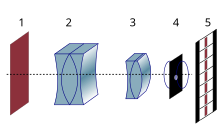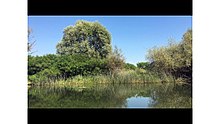Anamorphic image recording
Anamorphic image recording refers to the storage or transmission of images that have been distorted in one dimension. For the correct display of the images must be a scaling to the correct aspect ratio ( aspect ratio will be made).
The method is not limited to DVD playback or the 16: 9 format, but is also used, for example, when storing Cinemascope material on 35 mm film . The following description takes place using the example of the storage of 16: 9 material in DVD format, since most readers can understand it here. If a widescreen film is to be encoded, there are two options:
- The proportions are retained and the picture is reduced in size until the picture width is suitable for a 4: 3 television . However, areas without image information then remain above and below; the image appears to be viewed through a mailbox slot - hence the name letterbox .
The disadvantages are that not all of the available pixels (or space on a 35 mm film) are used. In addition, on a 16: 9 television, viewers see not only the horizontal black bars that are also transmitted, but also additional “bookends”, i.e. bookends, so-called vertical black areas. Although the 16: 9 televisions offer the option of zooming into the picture, the result of this interpolation occasionally flickers; especially with horizontal patterns the image appears restless.
- The other solution is not to encode the black bars and to fill all lines with image information. Since the PAL standard and the DVD standard allow a maximum of 720 pixels horizontally, the images then have to be compressed horizontally by 25%.
For playback on a 16: 9 television, the television rectifies this "anamorphic" image to the correct width. For a 4: 3 television, the DVD player compresses the picture vertically and creates the black bars above and below as fillings. A good DVD player shows anamorphic and letterbox-formatted films in the same way on a 4: 3 television set. With many players, however, this compression is not well implemented. In this case, unwanted patterns appear in the picture on a 4: 3, especially when panning the camera. TV. Newer 4: 3 televisions can also display 16: 9 content anamorphically without loss.
However, owners of widescreen TVs also see horizontal black bars in some films, despite the anamorphic image material. In such cases, the film was then filmed in a widescreen format such as Cinemascope or Panavision with an aspect ratio of 2.35: 1 (rarely also 2.76: 1; before 1970) or 2.40: 1 (after 1970).
In order not to have to cut off the edges again, compromises are made in the vertical resolution - unlike the letterbox bars created in the player, these bars are an integral part of the image material stored on the DVD. If Cinemascope / Panavision films are shown on a 4: 3 player, you can see both the letterbox bars and those permanently contained in the picture; on some DVDs the transition is also visible through a slightly lighter line or through a minimal gradation of brightness.
Anamorphically coded widescreen picture has a PAL resolution of 720 × 576 (or 704 × 576) pixels, i.e. an aspect ratio of 5: 4 (material with a horizontal resolution of 704 is supplemented by 8 black pixels on the left and right). The rectification does not change the number of pixels, but it does stretch the image so that it is displayed in the correct aspect ratio. Material in the old 4: 3 aspect ratio also has to be stretched, but due to the term anamorphic image recording is not used here.
It is not always possible to tell on DVD packaging which format the film is actually saved in. “ Widescreen ” can mean both anamorphically coded and letterboxing.




